
Janus Henderson: Euroland money trends cooling
Euroland coincident indicators remain strong but monetary trends suggest that economic growth will moderate in 2018.
30.10.2017 | 10:21 Uhr
The consensus interpretation of September monetary data, released yesterday, is likely to be upbeat. Annual growth rates of broad money M3 and narrow money M1 rose slightly, to 5.1% and 9.7% respectively, with the latter representing a 17-month high.
The forecasting approach here, however, focuses on non-financial monetary aggregates, i.e. excluding holdings of non-bank financial institutions – such holdings are less relevant for assessing near-term prospects for spending on goods and services. Headline M3 / M1 expansion has been supported in 2017 by a recovery in financial sector money growth following weakness in 2016. Annual growth of non-financial M3 has fallen from 6.1% in March to 5.0% in September, with non-financial M1 expansion retreating from 10.1% to 9.2% over the same period – see first chart.
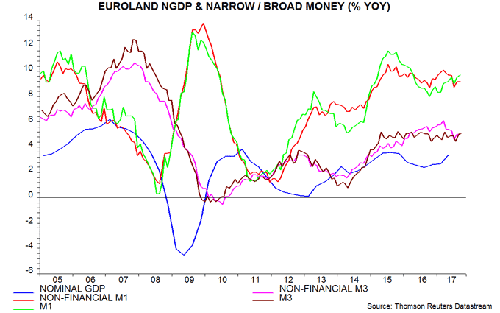
The year-over-year figures, moreover, conceal a sharper decline in six-month growth rates. Non-financial M3 rose by 1.7% or 3.4 annualised in the six months to September, with non-financial M1 up 3.4% or 7.0% annualised; these increases are the smallest over six months since 2014 – second chart.
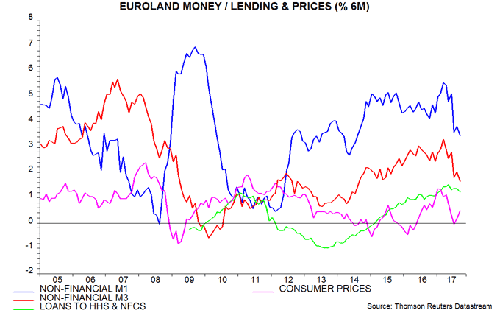
With six-month consumer price inflation recovering from a decline in the first half of 2017, six-month growth of the non-financial money measures expressed in real terms is also the lowest since 2014 – third chart.
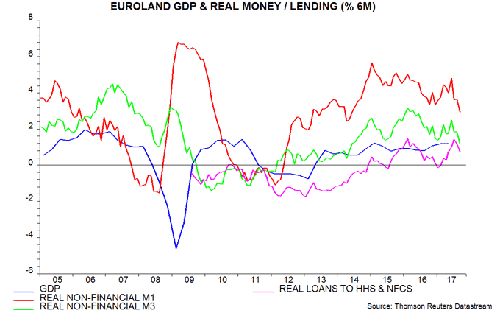
Real money growth remains respectable by longer-term historical standards, suggesting a modest loss of economic momentum rather than weakness. Any slowdown, however, could surprise a consensus relying on continued loose ECB policy – confirmed by yesterday’s news of a nine-months-plus extension of QE – to sustain a strong economy.
Why are money trends cooling despite ECB support and gradual banking-system healing? One probable driver is rising bond yields – average 7-10 year government yields in July 2017 were 60 basis points higher than in July 2016, representing the largest year-on-year rise since 2011. The fall in yields in response to yesterday’s ECB news may prove short-lived against a backdrop of rising US yields and a weakening euro.
ECB research found that real non-financial M1 has outperformed other money / credit aggregates as a leading indicator of the economy, with real M1 holdings of non-financial corporations displaying a stronger correlation with future GDP expansion than those of households. Six-month growth of real corporate M1 deposits was above that of household deposits in September but has fallen sharply since June – fourth chart.
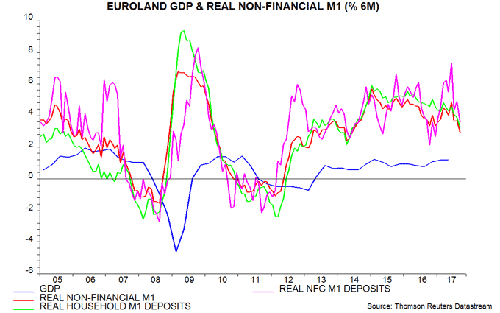
The country M1 deposit breakdown, meanwhile, hints at economic damage from Spanish political turmoil: six-month growth of real M1 deposits in September was the lowest since 2014. A rise in Italian growth, by contrast, suggests improving relative economic prospects – fifth chart.
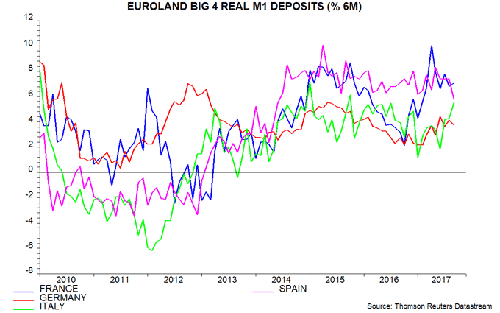



Diesen Beitrag teilen: